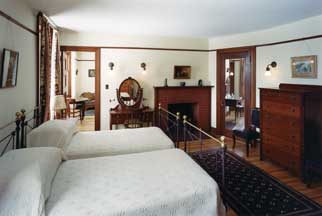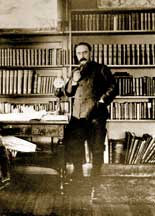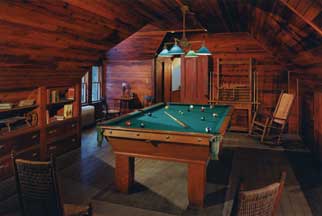Arts
Kipling's New England home a 'precious jewel'

|
There are plenty of famous authors’ homes that have become museums. In such houses, visitors may gaze in reverence upon the great writer’s books and furniture, but they aren’t encouraged to linger, drinking in the atmosphere for hours. Usually they aren’t allowed so much as to sit in a historic chair.
Fans of poet and novelist Rudyard Kipling, however, can do much more than simply visit the Nobel laureate’s home. They can actually spend their vacation in a house that he planned, built, lived in and loved. This is the house where he wrote the Jungle Books, Captains Courageous and other books and poetry, and began his work on Kim and the Just So Stories. Rudyard Kipling (1865-1936) was a British subject who was born in India during the Raj, the imperial era that he idealized and immortalized in verse and prose. Already internationally famous at 27, he moved to southeastern Vermont in 1892 after marrying Caroline Balestier, an American whose recently deceased brother had been Kipling’s dear friend. Kipling decided to build his own home near his in-laws’ home. It was to be a rural sanctum where he could enjoy his new family, savor his privacy and write his books. He worked with architect Henry Rutgers Marshall to design a uniquely long, shingled house full of Arts and Crafts-era workmanship. Kipling gave it an Indian name: Naulakha, or “precious jewel.”
Today, after spending much of the 20th century sadly neglected, the home near Brattleboro, Vt., has been restored to life through the Landmark Trust USA. The great green house perches like an ark on a hill overlooking the Connecticut River Valley, with a distant view of Mount Monadnock. Kipling loved Naulakha’s sunlit central room with its big windows looking out at this prospect. “The joy of the house,” he called it. The Landmark Trust, a foundation based in the United Kingdom, preserves and restores notable British houses. Its work is funded in part by renting the homes to vacationers, and Naulakha was its first American property. It rents for a minimum of three nights at $250 to $435 a night, depending on the season. It’s booked well in advance for Vermont’s most popular months, such as August and October. Many of the furnishings, such as the dining table and the day nursery’s brass beds, are Naulakha’s original ones. The master bedroom has the Kiplings’ own twin brass beds, and the master bath features a large, deep soaking tub where, the author wrote, he enjoyed “luxuriously parboiling myself … beholden to no man.” Kipling’s black leather morning chair is downstairs in his wife’s sitting room, and his golf clubs stand upstairs in a room that also holds the desk where he wrote the “Jungle Books.” Guests are welcome to bring their children, and dogs are allowed, too. With all that room to romp on Naulakha’s extensive grounds, the kids might not even notice that there is no television. Rudyard Kipling’s four years in Vermont were productive, and happy for the most part. His elder daughter was born there in 1893: Josephine, her father’s Best Beloved. As a toddler, she was the first child ever to hear the tales that became his Just So Stories. While at Naulakha, the Kiplings had another girl, Elsie, in 1895. Kipling’s visitors included other renowned writers such as Owen Wister and William James. Sir Arthur Conan Doyle brought his host a pair of Nordic skis – said to be the first ones ever used in America.
Kipling also built a tennis court, believed to be the first in Vermont. And he invented snow golf, using a ball painted red for visibility. For holes, he planted tin cans in the frozen crust that covered the snowy ground in sugaring season. Meanwhile, nearby Brattleboro viewed its celebrity resident with a certain native skepticism. “In the hardworking farm communities of Vermont, he was an oddity,” says David Tansey, Naulakha project manager for Landmark Trust USA. “He was thought of as a man who ‘didn’t work.'” Caroline Kipling and her family proved to be the undoing of Kipling’s Vermont paradise. His friends were never quite sure why Kipling married Carrie. Tansey says that Mrs. Kipling was nothing like her husband, who easily gathered friends around him and could be the life of any party. The writer Henry James, who was best man at the Kiplings’ wedding in London, called the event “a somber, dreary affair” and described Carrie as “a hard, capable little woman.” Eventually, Carrie had a serious falling-out with her feckless, alcoholic brother, Beatty, leading to threats, a lurid lawsuit trial and much negative publicity. The stress of this family feud, with most of their neighbors taking Beatty Balestier’s side, meant that Naulakha was no longer a peaceful refuge for the Kiplings. They left Vermont in 1896, taking only a few favorite furnishings, rugs, books and artworks. Back in England, Kipling told his friends: “There are only two places in the world where I want to live – Bombay and Brattleboro. And I can’t live at either.”
In 1899, 6-year-old Josephine died of pneumonia. Her heartbroken father couldn’t bear to return to the house where “my little American” had been so happy. In 1903 the Kiplings sold Naulakha to Mary Cabot, a family friend. Though subsequent owners added electricity and other changes were made, anything that was removed from the house was stashed in one of the estate’s barns. This Yankee thriftiness made the restoration of Naulakha considerably easier despite the fact that with the start of World War II, the house was uninhabited for five decades. Landmark Trust USA rescued it in 1992. The restoration took several years and hundreds of thousands of dollars, but Naulakha now looks remarkably as it did in Kipling’s day. “Those four years in America will be blessed unto me for all my life …” Kipling wrote to Harvard scholar Charles Eliot Norton. “It’s an uncivilized land (I still maintain it) but how the deuce has it wound itself around my heartstrings in the way it has?” One hundred and 10 years after he left, it’s easy to imagine that the man who built this special house would be immensely pleased if he could see Naulakha as it is now, with children once again at play upon his wide green lawns. Information on Naulakha: |




